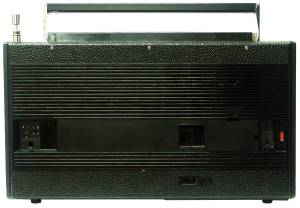Inhaltsverzeichnis
Grundig Satellit 2000
Manufactured by Grundig, Fürth.
After the Grundig Satellit 208 as the first world band receiver from Grundig to use double conversion was launched in 1967, the turret tuner of the Satellit 2000, which was introduced in 1973, was now arranged horizontally, in contrast to its predecessors Satellit 210 and Satellit 1000.
Variants
- Walnut: Speaker grille in wood look
- Black: Speaker grille black, forward-facing edges / trims silvery.
- Profi - Black: front-facing trims also in black
Technical data
- Frequency range: VHF, LW, MW, KW1 (1.6-3.5), KW2 (3.3-5.2), K3-K10 with switchable bandspread of the 49 / 41 / 31 / 25 / 19 / 16 / 13 & 11 m broadcasting band
- Frequency dial: analogue dial
- Frequency memory: none
- Features: antenna trimmer, FM-AFC
Power supply
- Mains operation: 110-127, 220-240 V
Dimensions
- 460 x 270 x 120 mm, weight 6.9 kg
Accessories
- SSB adaptor 2000, external BFO, connected via a special connecting cable
Operation
This heavyweight (6.3 kg) and bulky (46 x 27 x 12 cm) portable receiver was introduced in the early 1970s. It can be operated from 6 UM-1 batteries or from 110/220 V mains voltage as well as with 9 - 16 V DC voltage via an adapter cable.
Three horizontally arranged frequency dials occupy the right half of the front panel, with the tuning knob for the respective frequency ranges located the right. At the top, the dial for LW, MW and the two tropical band ranges of 1.6 - 5.2 MHz is located, in the middle is the dial window of the turret tuner, the 9 shortwave ranges are selected with a rugged band selector on the right face of the radio, a small switch in the centre bar selects the general coverage (e.g. 5 - 6.5 MHz) or the bandspread range (e.g. 5.9 - 6.25 MHz). With activated bandspread and a reasonably linear frequency response within a band, the reading accuracy is approx. 10 kHz. The dial accuracy is moderate: in order to re-tune to a frequency on which a certain station is active, a numerical value from a linear calibration dial with subdivisions from 0 - 100 has to be written down in a notebook. At the bottom, you find the FM broadcast band dial and the corresponding tuning knob, the AFC can be switched off with a slide switch in the centre bar.
Large push-buttons on the top face of the set, under the sturdy carrying handle, switch the set on and serve as frequency range selectors; other push-buttons switch between the built-in ferrite or telescopic antenna and an external antenna. Despite the existence of an antenna trimmer, the set reacts to longwire antennas with a tendency to overload and to generate intermodulation.
 The RF signal processing is limited to a switchable IF ceramic filter; despite the wide filter skirts, the separation of two stations in the 5 kHz grid is quite well with the narrow filter. Single sideband reception is only possible with the external SSB accessory known from the earlier sets in the Satellit series.
The RF signal processing is limited to a switchable IF ceramic filter; despite the wide filter skirts, the separation of two stations in the 5 kHz grid is quite well with the narrow filter. Single sideband reception is only possible with the external SSB accessory known from the earlier sets in the Satellit series.
The left half of the front panel is taken up by the speaker grill and the volume and tone controls, which are designed as slider controls. The large-format loudspeaker with an additional switchable tweeter is fed by the generously dimensioned audio final stage with 7 watts of music power.
In summary, the Grundig Satellit 2000 is a bulky world band receiver built in analogue technology, designed at its time for the traveller not suffering from lack of space, but usually used as a domestic receiver to catch the international shortwave services from Europe and the most powerful international stations. Due to the limited possibilities of signal processing and especially the inaccurate frequency dial, the Satellit 2000 cannot meet today's demands of a DXer, it performs unsatisfactorily in the tropical bands and, with the external BFO and the sets insufficient stability, is a poor performer on the amateur radio bands, but not suitable for serious SSB reception or even RTTY/FAX reception.
The Satellit 2000 differs from its successor Satellit 2100 by the different design, the sliding potentiometers as volume controls and the different AF preamplifier circuit.
Technical principle
Double conversion, analogue technology with bandspread on the shortwave broadcast bands.
Components
The set is equipped with semiconductors.





